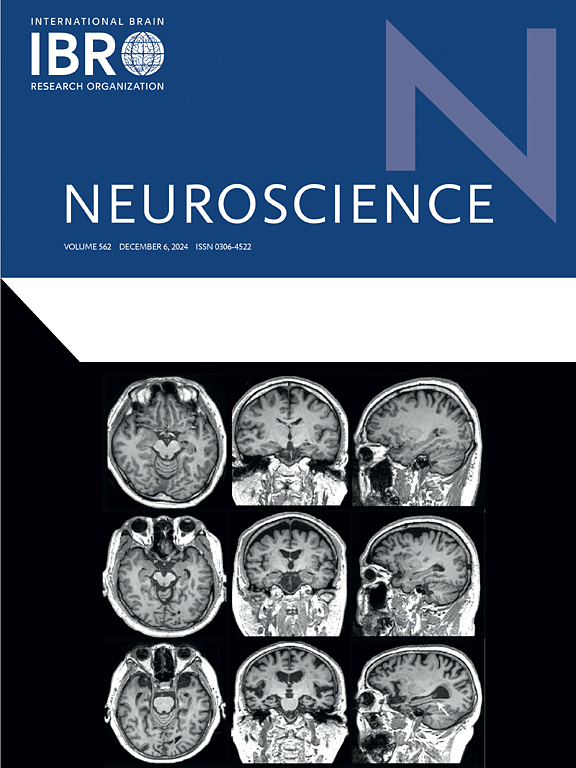Impairments in synaptic inhibition and glucose hypometabolism contribute to epileptogenesis in Wistar Audiogenic Rats with cortical malformation
IF 2.8
3区 医学
Q2 NEUROSCIENCES
引用次数: 0
Abstract
Epilepsy associated with malformations of cortical development (MCD) is often characterized by impaired cortical inhibition and altered brain metabolism, both of which play a key role in epileptogenesis. Recently, we reported the Wistar Audiogenic Rat (WAR), an epileptic-prone strain with induced cortical microgyria, exhibited increased ictogenesis and enhanced local cortical network synchrony, making it a reliable model to study epileptogenesis during development. The present study aimed to evaluate synaptic inhibition and glucose metabolism in several brain regions of this two-hit model of epilepsy (WAR-MCD) during the development. Unilateral cortical microgyria was induced via freeze-lesion in male and female neonatal WARs. Spontaneous and miniature inhibitory postsynaptic currents (sIPSCs and mIPSCs) were recorded in cortical pyramidal neurons adjacent to, distant from the microgyria, and the contralateral hemisphere during the juvenile and adolescent periods. Additionally, in vivo brain glucose metabolism was assessed during the same periods using [18F]FDG Positron Emission Tomography (PET) imaging. We observed significant reductions in amplitude, frequency and altered kinetics of sIPSCs in pyramidal neurons of MCD rats during the juvenile period. Synaptic inhibition deficits in paramicrogyral and contralateral cortices were even more pronounced in the two-hit model during adolescence. Glucose hypometabolism was evident in several brain regions of WARs and was further intensified in the two-hit model. These findings suggest an age-dependent disruption of cortical inhibition and glucose metabolism associated with MCD, further exacerbated by pro-epileptic conditions, contributing to epileptogenesis.

突触抑制和葡萄糖低代谢损伤参与皮层畸形Wistar听原大鼠的癫痫发生。
与皮质发育畸形(MCD)相关的癫痫通常以皮质抑制功能受损和脑代谢改变为特征,这两者在癫痫发生中都起着关键作用。最近,我们报道了Wistar听原大鼠(WAR),一种诱发皮质小回畸形的癫痫易感品种,表现出增加的ictogenesis和增强的局部皮质网络同步,使其成为研究发育过程中癫痫发生的可靠模型。本研究旨在评估这种两击癫痫模型(WAR-MCD)在发展过程中几个脑区域的突触抑制和葡萄糖代谢。通过冷冻损伤诱导单侧皮质小回畸形。在青少年和青少年时期,小回附近、远离小回和对侧半球的皮质锥体神经元中记录了自发和微型抑制性突触后电流(sIPSCs和mIPSCs)。此外,在同一时期,使用[18F]FDG正电子发射断层扫描(PET)成像评估体内脑葡萄糖代谢。我们观察到MCD大鼠幼年期锥体神经元中sIPSCs的振幅、频率和动力学显著降低。在青春期的双击模型中,小回旁皮层和对侧皮层的突触抑制缺陷更为明显。葡萄糖低代谢在WARs的几个脑区都很明显,并且在两击模型中进一步加剧。这些发现表明,与MCD相关的皮层抑制和葡萄糖代谢的年龄依赖性破坏,癫痫前条件进一步加剧,有助于癫痫发生。
本文章由计算机程序翻译,如有差异,请以英文原文为准。
求助全文
约1分钟内获得全文
求助全文
来源期刊

Neuroscience
医学-神经科学
CiteScore
6.20
自引率
0.00%
发文量
394
审稿时长
52 days
期刊介绍:
Neuroscience publishes papers describing the results of original research on any aspect of the scientific study of the nervous system. Any paper, however short, will be considered for publication provided that it reports significant, new and carefully confirmed findings with full experimental details.
 求助内容:
求助内容: 应助结果提醒方式:
应助结果提醒方式:


